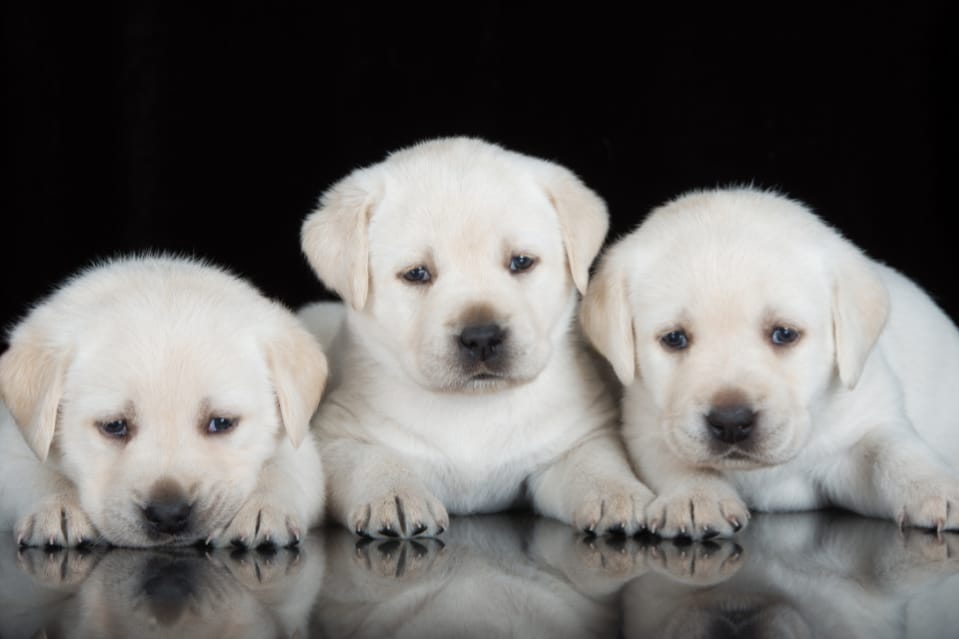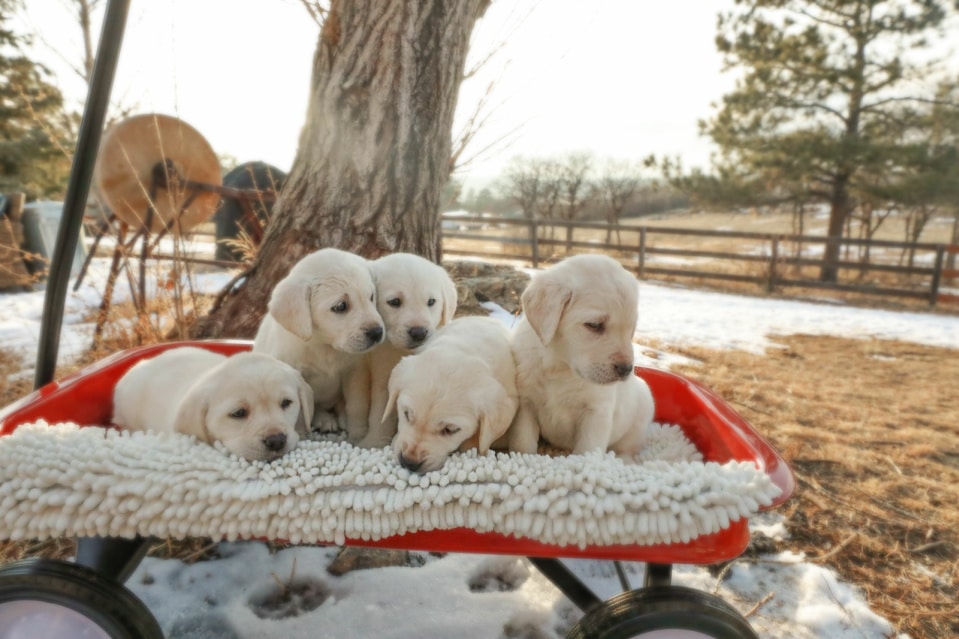Is your lady labrador expecting? If so, I’m sure you’re overjoyed, aren’t you? It isn’t easy to sleep at night knowing your house is going to filled with all of the happiness and that your dear labrador lady will soon become a mother. Labrador puppies are stunningly cute, but if you’re considering buying one, it’s essential to know what you’re in for. Here are some things you need to know before adopting a labrador puppies.

Despite the fact that labs are still charming when they are grown up, the cuteness of puppies can’t beaten. Moreover, before allowing the labrador to pair up or conceive, each detail should considered by the pet owner.
Right now, you would have a lot on your mind like how many puppies do labs usually have or whether or not you should prepare a room for the soon-to-be mother. Make sure you have the room, as well as the finances and patience to handle the situation.
Always keep in mind that it is you and the mother who will be taking care of these little creatures. The decision is yours, but puppies should nurtured by their mothers for at least two months. You should therefore have your home ready to welcome labrador babies.
Smart instincts are a hallmark of the Labrador breed. The birthing process isn’t stressful for this breed. Nothing needs to worried about. Yet there are a few things that people are really concerned about.
People often ask, “How many puppies do labs usually have?” or “How many puppies do labrador have in the first litter”? Despite the wide variance in results, experts have come up with a general idea of what litter size to expect.
Therefore, in today’s article, we’ll discuss not only the lab’s litter size but also what needs to be complete before and after the birth of puppies in order to ensure everything goes smoothly. Keep reading.
How Many Puppies Do Labrador Have?
Compared to other breeds of dogs, labs are somewhere in the middle.
Study findings from Labrador experts and “American Kennel Club” found that – Labradors tend to have five to ten puppies per litter. However average litter size is “7”.
The size of a litter may vary based on factors such as medical condition, physical fitness, health, nutritional intake, and genetic variation.
There was, however, the 2nd largest labrador litter ever recorded: “14 puppies” delivered by a black labrador in the UK in 2020. Incredible, huh? But there’s more. We will also discuss the 1st-ever large Labrador litter.
Labrador puppies are generally born between 58 and 64 days after being conceived. There is an interesting relationship between pup count and the time to expect your labrador to be pregnant-free. One of the reasons for this is that there is not enough space and not enough sustenance to sustain the baby.
In addition, it is not necessary for you to take your lady labrador to the veterinarian in order to deliver her since this can be adept without having to leave your home under the appropriate circumstances and precautions.
It is simply a matter of offering some privacy and relief to the expectant mother. It’s important to remember the need for care and attention during the first few days, especially following the birth of puppies.
In any case, if you see the dog behaving strangely, it is a sign of the fact that the puppies are waiting to be born.
How Many Puppies Do Labs Have In Their 1st Litter?
Labrador’s on average in the 1st litter give birth to puppies between one to twelve depending on various factors such as age, physical condition, and mother’s size.
Different breeds have different litter sizes, and dogs of large breeds have a tendency to breed more babies in comparison to dogs of small breeds. In addition to different breeds, there can also be differences between similar breeds of dogs.
When it comes to Labradors, their first litter usually consists of 7 puppies.
On the other hand, it is also important to note that other factors may come into play during this process, which may affect how many puppies your lab lady produces in her 1st litter.
Even at the first litter, older labradors are capable of having up to 14 puppies.
Is This Your Labrador Lady’s First Litter?
First pregnancies are always exciting both for humans and canines. However, in the case of labradors, the litter size affected as well. Interestingly enough, if this is the 1st litter of puppies for the female dog, chances are fewer puppies will be born.
What is the reason? Because a newly pregnant mother has a smaller uterus, the body still has to adjust for pregnancy, labor, and delivery. Heredity and evolution play a role in the small size of the first litter.
Generally, female labradors have the biggest pregnancies during their third and fourth pregnancies. From her first two pregnancies, two to three more puppies aexpected. However, as she reaches her fourth pregnancy, fewer puppies expected.
In light of the above, it is important to note that the majority of vets advise against breeding dogs beyond the fourth time. The health of your dog varies from one to another, so if you’re planning to breed, you should consult your veterinarian to determine how often she should breed and when it is appropriate to breed.
Factors Affecting Litter Size In Labrador Retrievers
The truth is, litter sizes aren’t fixed by nature, and they certainly aren’t under human control, although humans can handle a number of factors that influence the size of litters in labradors.
Labrador parents and the dog centers should be happy to hear that there are a number of factors that contribute to the larger litters.
To get the best labrador puppies, your best strategy involves paying close attention to the dietary needs, well-being, and physical activity of both DAM and SIRE.
So without further ado, let’s examine each factor in-depth to help you determine your desired litter size from your lady labrador.
The Health Factor
Litter size influenced by health in many ways, so health is the key factor here. Simply put, it is necessary for both female and male labradors to be in good health with the goal of producing the largest litter of puppies possible.
When it comes to pet parents, to have the most puppies possible from your female lab, you should pay attention to her health. As no unhealthy labrador female can carry large litters.
There is an important distinction to be made about the fact that health is what is being discussed, and this does not necessarily imply a labrador is obese. Before you breed your labradors, you should consider how slim or overweight they are.
Supplementing the male as well as female Labrador with the best nutrition is key to increasing litter size.
Female Labrador’s Age
Prior to anything else, the age of the female labrador is the determinant of how large the litter will be.
When compared to the litters of other breeds, the 1st litter of a female lab is usually small. The likelihood of a small litter is high if the bitch is under seven years old. However, it does not influence the size of a litter exclusively, in which case miracles can occur, such as the lab producing a larger litter at an early age.
Male Labrador’s Age
The size of the litter is not only affected by the female labrador, but also by the male labrador, although to a lesser extent.
Young labradors must used for breeding because aged dogs will not release as much sperm and it will somehow affect the size of the litter.
Labrador sperm count is high in the male of 5 years old, indicating that the litter will be healthy and large. It is therefore very important that breeding takes place at about the age of 5 years old for both male and female labradors.
Genetic Pool
Apparently, it’s not just female labradors who contribute to litter size – some way or another, male labradors also play a role in litter size. Genetic pool plays no role in litter size since only fertility affected.
Aside from fertility, characteristics are primarily handed down from generation to generation. There are times when you will notice, such as with purebreds, that their eye color or size is not influenced by their genetic makeup, but these traits are inherited.
Diet Matters
Happiness can never achieved through a bad diet. Everyone knows this. Having a poor diet will prevent a female labrador from giving birth to as many puppies as she should. To ensure that your female labrador has a large litter size, it is essential that she is provided with a high-quality diet all year long and not just when breeding season arrives.
Providing your female labrador with a high-quality and appropriate amount of nutrition will surely increase the furtiveness of your female labrador.
Besides providing her with a nutritious diet, make sure she gets plenty of physical activity and proper exercise to stay in shape. When it comes to the female labs, they weigh between 55 and 70 pounds which is equivalent to 25 – 32 kilograms.
Remember – Supplements is not the solution here and generally not recommended; a diet with a variety of nutrients is.
More importantly, the food should be low in carbohydrates and high in protein so it won’t cause any harm to the mama labrador.
Best Food For Pregnant Labradors
In recent years, we have learned that pregnant labradors need high protein diets in order to be healthy. The nutritional needs of pregnant dogs are similar to those of pregnant women. In addition, they need certain vitamins and minerals in their diet. During your pup’s pregnancy, you want to ensure that she gets the best nutrition. In light of this, we need to learn which is the most appropriate high-protein food for pregnant labradors.
You can quickly become overwhelmed with all the choices you have when it comes to buying dog food for your lady labrador. The best dog foods for pregnant labradors compiled for your convenience.
Here’s a list of the top 9 best dog foods for labradors.
- Royal Canin Mother Dog Food
- Victor Dry Dog Food
- Diamond Naturals
- Instinct Natural Dry Dog Food
- The honest kitchen Dog Food
- Tuffy’s Pet Food
- Evanger’s Dog Food
- Nulo Grain Free Dog Food
- Nature’s Recipe Easy To Digest Dog Food
An Unabridged Birth Gap
Lastly, the unabridged gap from birth to birth contributes to larger litter sizes among female labs. A litter from 2 years ago, for example, would not be the same size.
Prior to pursuing a breeding session with your labradors, you should consult with a veterinarian. Keeping the proper gap between the two will not cause the litter size to decrease. However, having consecutive pregnancies will reduce the litter size.
Other Considerations
On top of the factors discussed previously, there are other factors that impact litter size:
Mate Rate – According to the majority of the people, if a female only mates once, she will have a smaller litter. We recommend allowing them to mate every couple of days if they are necessary, but you must stop when the female refuses to mate. If you do not stop a female labrador when she refuses to mate, you will put him under a great deal of stress, prohibiting him from having successful breeding.
Season – Most commonly, Spring is the most common seasonal time for a labrador to give birth, during which she gives birth to a large litter. However, when breeding occurs in the summer, smaller litters are born.
Breeding type – It is generally acknowledged that naturally bred animals deliver more puppies than artificially bred ones. When artificial insemination used, the number of puppies produced drops by up to 15%.
One-Half Rule
All mammalian species tend to follow the same underlying rule. According to the rule, the number of babies a female gives birth to is equal to the number of nipples on her body. Quite intriguing, isn’t it?
There is some evidence to support this rule. Typically, a female dog has between 8 to 10 nipples, which explains why litter size is typically 7.
Two of them, of course, found in humans. It is common for mothers to have a single baby at a time, but twins can also be born. Although it is not unheard of, having three or more children in the same body is extremely rare as nature ensures sufficient care and nutrition for every child.
Don’t count your lab’s nipples yet. These results are merely correlational. Don’t use them as a prediction tool. If you want to know the size of your litter, make an appointment with the veterinarian.
Best Age For Labrador To Be A Mama
Females shouldn’t bred until they have reached maturity. Labradors belong to the large breed category, which means that they mature between 18 and 24 months. Which means that breeding should avoided up until her 3rd heat cycle and approximately two years of age.
Pregnancy Symptoms In Labradors
Labs only take about two months to gestate. It’s hard to see and interpret the signs since there isn’t much time. The vast majority of pet parents are surprised when they discover their lab lady pregnant in the final days before the delivery.
A Labrador’s pregnancy is indicated by a variety of signs. Your lady labrador may exhibit these signs as she prepares to give birth to a litter of puppies.
- An appetite loss
- The dog gets tired quite rapidly
- Start to sleep more than usual
- Food consumption is less or nonexistent
- Rigid abdomen
- Her affectionate nature grows, and she craves attention more frequently
- Frequently crying – pain could be to blame
- Put on weight
- Nipple’s new shade of pink
Vet Can Help Finding Out How Big A Litter Is
Since we have already explained, the number of pups a labrador carries is unpredictable under numerous circumstances so there’s no way to predict how many puppies you are going to have but there’s one thing for sure.
In this case, your veterinarian can assist you. A pregnant female can be x-rayed to see how many pups are in her belly. Puppies with skeletons are seen during this process. A dog’s litter size can be determined through this method.
Even though it’s not a guarantee, there’s a chance of missing a puppy throughout this process as you’ll be able to estimate how many puppies you’ll have. For a puppy’s skeletal system to develop, she needs to be pregnant for at least 6 weeks.
Other methods to estimate the litter size include the following:
- Ultrasound scans
- Abdominal palpation.
Mama Labrador Ready To Give Birth: How To Help
Female Labrador giving birth is an incredible, exhilarating, and sometimes breathtaking experience you will surely remember for the rest of your life. Whether you’re wondering how you can help mama labrador give birth easily or not, there are several ways you can help. Below are a few suggestions.
Before you assist your labrador in giving birth, consult your veterinarian and gather the necessary supplies.
It is important to make sure that your dog has an appropriate environment, preferably a litter box so that she has space to explore, but also to be aware of her needs.
Some may be surprised to learn that labs are very capable of self-sustaining during the birthing process, as are many other breeds. This is not to say you won’t have to participate in the process. Understanding when to provide assistance and when to let her handle things independently is an essential part of the process.
- The vet should be kept on hold for emergency purposes.
- Gather essential supplies such as cleaning towels, blankets, heating pads, gloves, and sterilized scissors.
- Maintain a clean and comfortable environment that is conducive enough to deliver puppies.
- She will need to be calmed because she will soon be in a lot of pain crying for help.
- The puppies’ thin membrane must be removed after birth in order to prevent them from suffocating. It takes a minute or two for the mama labrador to do this, so you’ll have to intervene.
What Is The Maximum Number Of Puppies A Lab Can Have During Their Lifetime?
Due to her heat cycle, labradors have heat cycles twice a year, allowing them to give birth every 6 months. Let’s say a female begins reproducing at the age of two and keeps doing so until her eighteenth birthday.
If so, her lifetime litter count would be 13. Labrador puppies usually have six to seven pups on average. In fact, litter size changes throughout the year depending on a variety of factors.
As a hypothetical case, assume the lab lady continuously delivers seven kids during every heat cycle. Consequently, female labradors are capable of bearing 90 puppies in their lifetime. Isn’t that incredible?
Do Puppies Have Different Birth Dates?
No, the dates of their birth are the same, but the times are different. There is usually a 45-60 minute interval between puppies. But it is possible for the mama dog to rest for as long as 4 hrs between puppies.







